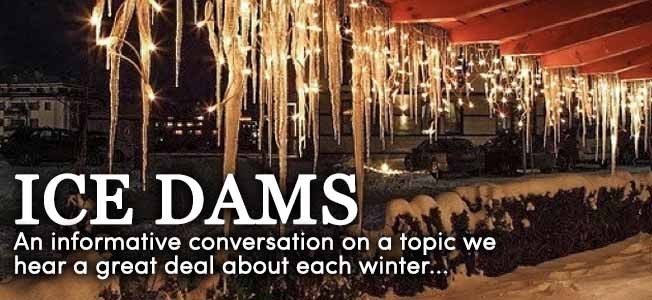The Ice Dams Cometh
December 21, 2015 | Filed under: Energy,Homeowner Tips,Newsletter Articles

Let’s have an informative “conversation” on a topic we hear a great deal about each winter – ice dams. While much of North America has enjoyed fairly mild weather the past few weeks, we know that severe winter is inevitable. Rooftop ice dams can be stressful for homeowners due to the damage they can cause.
So, why do ice dams occur and why should you be concerned about them?
Ice dams occur when snow melts over the living spaces of your home and then the resulting melted water runs down the roof until it reaches the home’s unheated overhangs, where it re-freezes. The result is a dam of ice along the bottom edge of your roof that prevents other melted snow from flowing off of the roof. Instead, that melted snow just builds up additional layers of ice, increasing the size and potential damage of the ice dam.
Ice dams can cause annoying icicles and frozen gutters. These symptoms can progress creating serious damage to gutters, and then even to water and ice working their way under your roof system and into your home’s walls and ceilings. The longer you experience low outside temperatures, the more the ice dam grows, and with that the chance of serious damage.
How can you protect against ice dams and their damage to your home?
The first option is to try to drop the temperature of your roof system. If you can increase the ventilation beneath your roof system and the insulation on top of your home’s ceilings, you can help prevent the heat inside your home from reaching the roof and melting the snow. If roof top snow only melts due to an increase in outside temperatures rather than due to the effects of inside heat reaching it, then the snow melts over the entire roof evenly, and ice dams are avoided.
For some homes the shape of the roof or the construction of the attic and roof assembly makes ice dams all but unavoidable. For example, homes with cathedral ceilings where there is little ventilation and perhaps not much insulation are prone to ice dams. Additionally, homes with areas on the roof where sliding snow “log jams” into valleys or other tight areas can also be prone to ice dams.
For these situations, one option is to add a “cold roof” over the existing roof. A cold roof is vented so that the rooftop stays cold and the snow melts evenly over the entire roof due to outside temperatures only. The perfect time to add a cold roof is when the home is re-roofed. A cold roof can also help end any problems that have been experienced with condensation inside the home or attic. However, a cold roof is not inexpensive and, with homes that have complex or multi-level roofs, it can be very difficult to build – sometimes even impossible.
Another possible solution for persistently troublesome ice dams is some sort of rooftop heating system. A rooftop heating system can be used to warm the roof areas where ice collects and builds. Such a system needs to be accompanied by a way to heat the home’s gutters, as well, so that the melted water can flow away from the roof and house. While there are several commercially available roof-warming systems available, many of them involve unsightly and problem-prone heating cables on the roof. We at Classic Metal Roofing and Isaiah Industries are working on developing other roof heating methods and will be happy to discuss those options with you.
One thing that many homeowners may wonder is whether a metal roof will end the ice dam issues on their roof. We are quick to point out that while a metal roof does have some attributes that can help with ice dams, it still does not offer the thermal benefits that will end all ice dams on all roofs. More information can be found here on the subject of metal roofs and ice dams, provided by roofing expert and Classic Metal Roofing Systems president, Todd Miller.
You can explore our website for more information on metal roofing.
